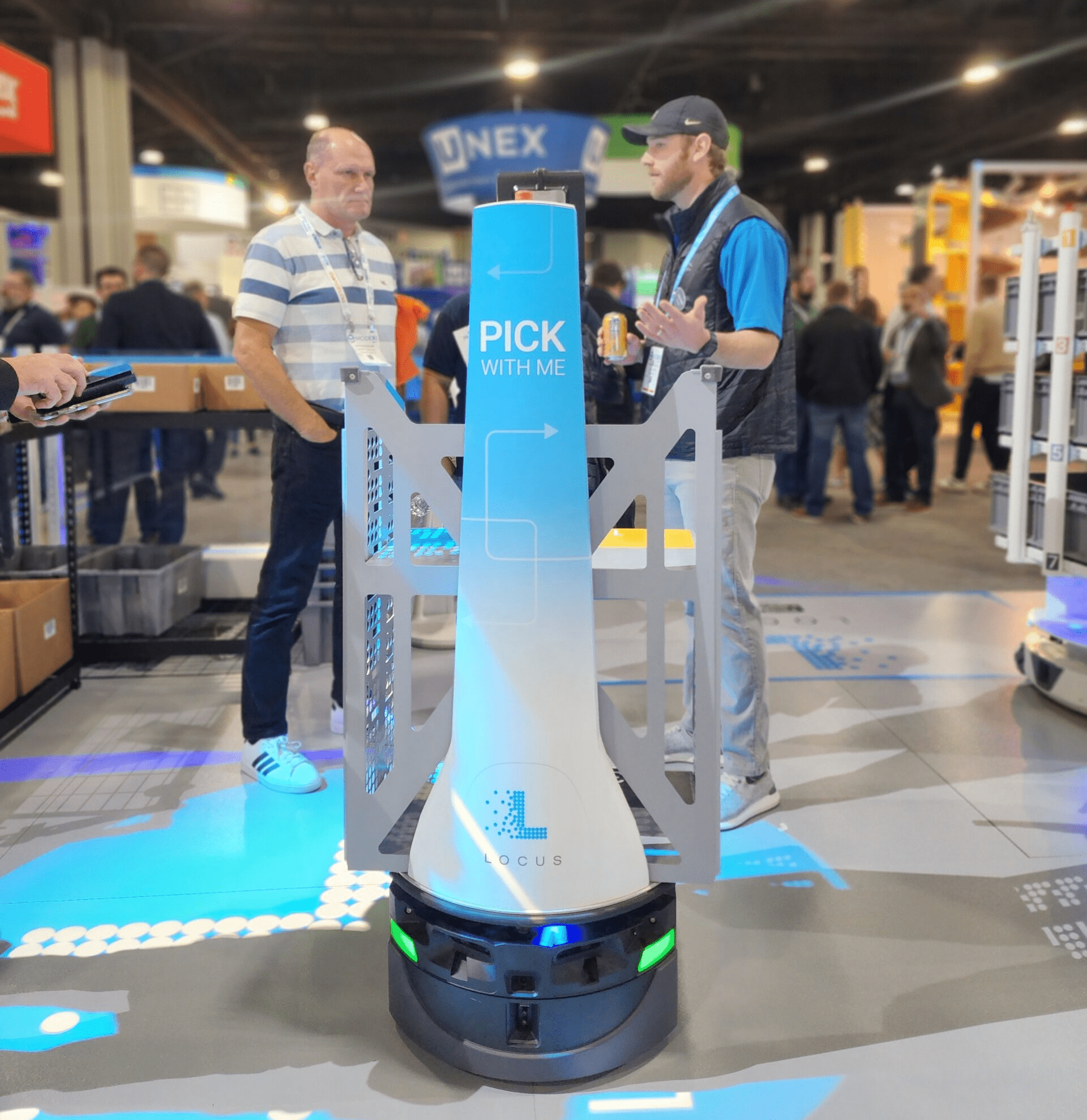Webinar Registration: The P2G Advantage
Webinar Registration: The P2G Advantage LEARN MORE
Meeting Peak Period Labor Challenges Using Collaborative Robots
Rick Faulk, Chief Executive Officer

The explosive growth of e-commerce, frequent seasonal promotions, and meeting service-level agreements are creating more peak periods than ever in the DC. These peak periods bring unique challenges to your fulfillment center, and no other time of the year is more challenging for e-tailers and 3PL’s than the period between Thanksgiving & Christmas.
We've all experienced the labor challenges of dealing with seasonal peaks: You hire 400 temporary workers, just to keep just 200. Spend days and days training new pickers to only find that they leave just a few days after starting. Pay signing bonuses and higher wage rates to recruit workers, only to find that they are your worst performers. In addition, operators find that adding temporary, seasonal workers can have a negative effect on the overall productivity and morale of your core team.
I hear these types of labor challenges very frequently from our prospects. They tell me it heavily compromises their ability to compete in the marketplace and meet their customer SLAs. So, how can you address these labor challenges?
Addressing Labor Challenges Through Robotic Automation
Whether you’re an e-tailer operating your own ecommerce distribution facility or a 3PL, the new strategic imperative is adding robotics and automation. They help you effectively compete and give you flexibility to service your seasonal peaks – without adding or changing your current labor force.
Robotics can more than double UPH rates, decrease cycle times, and significantly reduce training. Based on results from real customers such as DHL and GEODIS, (put link links to videos) deploying collaborative autonomous mobile robots is quickly producing real economic benefits and taking a major bite out of the labor challenges. And … of course, these benefits are realized for non-peak periods as well!
Flexibility & Scalability to Address Peaks.
We’ve found that scaling to meet the super peaks can sometimes also mean adding additional temporary labor, even in automated environments. This often involves training that may take days before a worker is productive. Instead, with a solution like Locus, temporary associates can be trained and be productive within minutes of walking on the floor, thus enabling the operation to easily scale to meet the super peak demand. Plus, our intuitive UI even automatically recognizes a worker’s preferred language on screen, helping maximize picking speed and ensuring near-perfect order accuracy.
Collaborative robotics solutions such as Locus Empower provide the flexibility to work standalone or operate in tandem alongside a manual RF environment. This “tandem capability” provides the ultimate flexibility to deal with “super peaks” such as Black Friday and Cyber Monday.
With the Locus Robotics unique Robots-as-a-Service model (RaaS), facilities can scale very easily by simply adding more bots at peak. Additional bots can be “working” at full capacity in a fulfillment center within five minutes of being unpacked. No more desperate last-minute calls to the temp staffing agency. No more busing temp workers in from an adjacent city. With the Locus Peak RaaS program, there’s no capital expense to add more robots.
Quick Training + Less Walking = Higher Productivity.
Traditional cart picking styles have workers walking through the warehouse, often for miles, pulling a cart to pick multiple orders. Our LocusBots minimize this unproductive worker walking time and eliminate carrying or pushing carts by autonomously travelling to the specific pick locations. The worker, instead of walking or following the robots through the warehouse, stay in specific areas, letting the robots come to them for the pick. LocusBots automatically learn the most efficient travel routes, based on their orders, to maximize overall pick efficiency, and instantly share information with the other robots. Workers spend less time walking to pick locations and spend more time picking, dramatically increasing throughput while minimizing worker fatigue.
With the new Locus “gamification” functionality, associates get real-time feedback on their UPH rates, the team’s progress towards the overall goal & performance data compared to other associates. This type of feedback is important to optimize productivity at peak, for both associates and management.
Cross Train & Simplify Processes.
To maximize output, you should cross-train your full-time associates, especially for those jobs that require special training. For example, everyone should know how to pick to the bots whenever more labor hours are needed to complete the wave and meet your SLAs. Fortunately, training on the bots is measured in minutes … or even seconds!
It’s also important to look for opportunities to simplify processes wherever possible. For example, I’ve seen picture boards in packing areas that clearly illustrate how to pack specific products. The visuals really seemed to simply the process and speed up operations.
Efficiently Expedite the Expedites.
No matter how efficient your fulfillment is, there will always be many more expedited order requests during peak season. It's essential that the increased levels of special handing can be supported without impacting the other service levels. Collaborative robotics systems such as Locus can easily process expedited orders seamlessly and efficiently without disrupting other processes.
Deploy in a Few Weeks … Get Ready for Peak.
It may sound daunting, but by taking steps now, e-tailers & 3PLs can adequately prepare for demand spikes, meet and exceed their SLAs, and ease the stress of the holiday season.
If you’ve been around the logistics industry for years, the claim of any automation system being operational in weeks may seem like hype. But it’s true. The Locus system is specifically designed to be deployed in existing facilities within a few weeks.
Here’s how we do it:
Our Locus System Engineers start by spending a few days meeting with your team, gathering historical data, and reviewing the facility layout before designing a custom solution. Then, our Customer Success team is dispatched to your site to properly integrate, configure, and implement the system, getting you online in just a few weeks.
The integration into your WMS is fast and easy. We utilize our pre-built connectors to all major WMS vendors, such as JDA & Manhattan Associates. Even home-grown systems are no problem. Our robust set of APIs make for a very easy integration.
Since there are virtually no infrastructure changes required, Locus can be quickly configured and deployed in most all existing distribution centers, having you fully operational in just a few weeks.
Execution is the Key.
Once all of your planning and prep work is done and your Locus collaborative robotics system is operational, it’s time to execute for peak season. It’s critical to have key metrics in place so that productivity and goals can be easily measured against the targets. At Locus, we have an array of tools and reports to provide visibility into operations. In fact, the entire picking process can be monitored on a mobile device. These tools help you manage through peak times with the proper visibility into volumes, inventory levels, order fill rates, and productivity rates so you can proactively address problem areas and challenges and ensure that necessary adjustments are made so that your projected goals are met.
NOW is the Time to “Scale the Peak.”
It’s not too late to start planning and getting ready for peak. I highly recommend scheduling one of our Solution Design Workshops (SDW) onsite at your facility. We’ll help you understand your volumes at peak and design a solution that will deliver the target economics you require.
Click here to learn more about scheduling a Solution Design Workshop.
About the Author
Rick leads the executive team with over 30 years of experience in executive management, sales and marketing for some of the world’s most successful technology companies such as Intronis, j2 Global, WebEx, Intranets.com, Lotus Development, Mzinga, and PictureTel.Rick leads the executive team responsible for the overall strategy and execution at Locus Robotics. Rick currently sits on various boards including Influitive, and Ntirety and is an advisor to a number of early-stage companies. Past board positions include Yodle, Virtual Computer, Bidding for Good, Skill Survey, BlueRaven and Centive.




